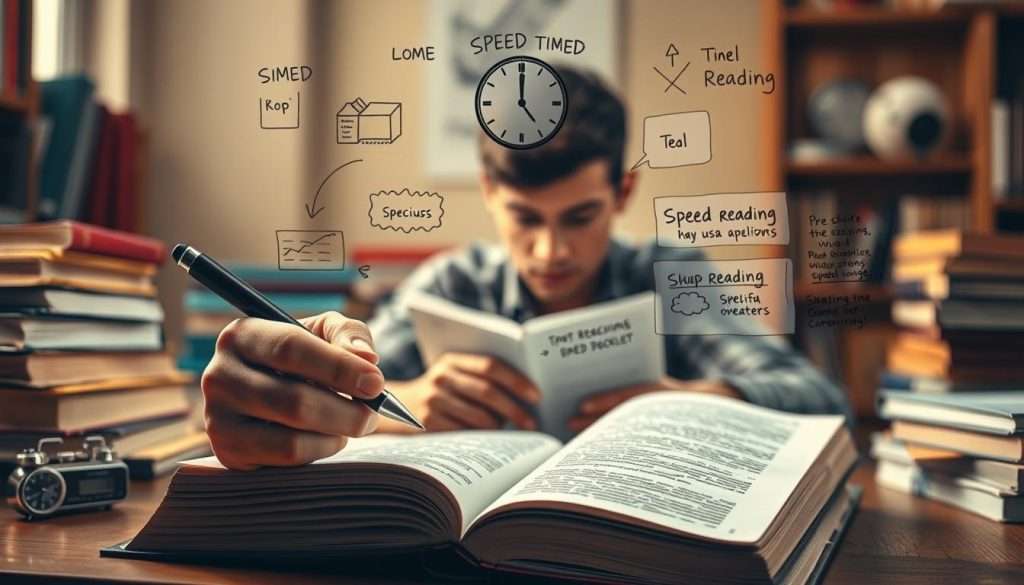Are you tired of getting lost in a sea of text? Struggling to keep your focus? In today’s fast world, quick information processing is key.
Improving your reading speed can change the game. It lets you take in and remember more in less time. With the right speed reading techniques, you can boost your productivity and reach your goals faster.
Key Takeaways
- Discover the benefits of speed reading and how it can improve your daily life.
- Learn simple techniques to improve your reading speed and comprehension.
- Understand how to eliminate distractions and stay focused on your reading material.
- Explore strategies to enhance your retention and recall of information.
- Find out how to apply speed reading techniques to different types of texts and materials.
The Power of Speed Reading in Today’s Information Age
In today’s fast world, reading quickly is key. We face a flood of information from everywhere. This makes it hard to keep up in our personal and work lives.
Why Reading Speed Matters in the Digital Era
The digital world has given us a lot of information. Effective reading strategies are vital to keep up. By reading faster, you can stay current without feeling swamped.
The Benefits Beyond Just Reading Faster
Speed reading has more than one benefit. Two big ones are:
- Improved Comprehension and Retention
- Time Management and Productivity Gains
Improved Comprehension and Retention
Speed reading doesn’t mean you miss out on understanding. In fact, fast reading techniques can help you understand and remember better. Your brain gets better at handling information quickly.
Reading faster saves time. You can use that time for other important things. For example, a student can quickly get through homework, and a professional can quickly read industry reports.
Adding effective reading strategies to your daily life can change how you read. It can help you learn more efficiently for the rest of your life.
Understanding How We Read: The Science Behind Speed Reading
To unlock the secrets of speed reading, we first need to understand how our brains process written information. This understanding is crucial for developing effective speed reading exercises that not only increase reading speed but also enhance comprehension.
Eye Movements and Fixation Points
When we read, our eyes don’t move smoothly across the text. Instead, they make quick jumps (saccades) between fixation points where they pause to process information. Research shows that the average reader fixates on almost every word, which can slow down reading speed. By training our eyes to take in more information at each fixation point, we can significantly increase reading speed.
Cognitive Processing During Reading
Cognitive processing plays a vital role in reading comprehension. Our brains process information in chunks, and the ability to group words into meaningful phrases can enhance rapid reading skills. Techniques that improve cognitive processing during reading can help readers maintain comprehension while speeding up.
The Role of Subvocalization in Reading
Subvocalization, or the habit of pronouncing words in your head as you read, is a common trait among readers. While some subvocalization is unavoidable, excessive subvocalization can limit reading speed. By becoming aware of subvocalization and practicing techniques to minimize it, readers can develop more efficient speed reading exercises.
| Reading Technique | Effect on Reading Speed | Impact on Comprehension |
|---|---|---|
| Reducing Fixation Points | Increases | Minimal Impact |
| Minimizing Subvocalization | Significantly Increases | Potential Decrease if Not Done Properly |
| Chunking Information | Increases | Improves |
By understanding the science behind how we read and applying techniques to improve our reading efficiency, we can all develop rapid reading skills. Whether you’re looking to read more books or simply want to increase your reading speed, the right techniques can make all the difference.
Common Misconceptions About Speed Reading
Let’s explore the world of speed reading and clear up some common myths. Many of us think reading fast means sacrificing understanding. But it doesn’t have to be that way.
Can You Really Read 1,000+ Words Per Minute?
Many believe you can read over 1,000 words per minute. But, this often comes at the cost of understanding what you’re reading. Studies show adults usually read between 200-300 words per minute. At these speeds, they can grasp the material much better.
| Reading Speed (wpm) | Comprehension Rate |
|---|---|
| 200-300 | 80-90% |
| 400-600 | 60-70% |
| 1000+ | Below 50% |
Does Speed Reading Sacrifice Comprehension?
Not always. Effective reading strategies can boost both speed and understanding. Methods like meta guiding and chunking make reading more efficient.
Is Speed Reading Suitable for All Types of Content?
No, different content needs different reading styles. For example, technical or academic texts often require a slower pace to grasp the information.
By grasping these differences, you can use speed reading techniques better. This will improve your reading comprehension in various texts.
Essential Speed Reading Techniques for Beginners
To unlock your reading potential, you need to master a few key techniques. These make a big difference. As a beginner, start with methods that are both effective and easy to use. We’ll explore some of the most powerful speed reading techniques for beginners.
The Meta Guiding Method
The Meta Guiding Method uses a guide to direct your eyes as you read. This technique helps maintain focus and increases reading speed. It ensures your eyes move smoothly across the text.
Using Your Finger or a Pointer
One simple way to implement the Meta Guiding Method is by using your finger or a pointer. This old-school technique is surprisingly effective. It provides a clear visual guide that helps you stay on track and avoid subvocalization.
Setting the Right Pace
When using the Meta Guiding Method, it’s crucial to set a pace that’s slightly faster than your comfortable reading speed. This encourages your brain to process information more quickly. It helps you improve your reading speed over time.
Chunking Words and Phrases
Chunking involves grouping words together into meaningful chunks rather than reading individual words. This method leverages the brain’s ability to process larger units of information. It significantly boosts reading speed.
For example, instead of reading “the cat sat on the mat” as separate words, you can chunk it into “the cat sat on the mat” as a single phrase. This reduces the number of eye movements and enhances comprehension.
Eliminating Regression and Backtracking
Regression, or backtracking, is a common habit where readers revisit previous text. Eliminating this behavior is crucial for improving reading speed. To break this habit, focus on maintaining a steady flow and trust your initial comprehension.
| Technique | Description | Benefit |
|---|---|---|
| Meta Guiding | Using a guide (finger/pointer) to direct your eyes. | Improves focus and reading speed. |
| Chunking | Grouping words into meaningful chunks. | Boosts reading speed and comprehension. |
| Eliminating Regression | Avoiding backtracking while reading. | Enhances reading flow and efficiency. |
By incorporating these techniques into your daily reading practice, you’ll be well on your way to improving your reading speed and becoming a more efficient reader. Remember, the key is consistent practice and patience as you adapt to these new methods.

Advanced Speed Reading Methods for Experienced Readers
Now that you’ve learned the basics of speed reading, it’s time to get better. As an experienced reader, you want to read faster and understand more. We’ll show you the best ways to reach your reading goals.
The Skimming and Scanning Approach
Skimming and scanning are great for reading faster. Skimming lets you quickly see headings and bullet points to get the main ideas. Scanning helps you find specific info in a text. These skills help you know what’s important and find what you need fast.
When to Skim vs. When to Deep Read
It’s important to know when to skim and when to read deeply. Skim for an overview or to see if a text is relevant. Deep read for complex or important texts. This way, you can read more efficiently and understand better.
Peripheral Vision Expansion Techniques
Seeing more words at once is key to advanced speed reading. You can practice with flashcards or special software. These methods help you read faster without losing understanding.
The Pomodoro Technique for Sustained Reading
The Pomodoro Technique helps you stay focused while reading. Work in 25-minute blocks, then take a 5-minute break. It’s great for reading complex texts because it keeps you engaged.
To improve your reading, try these tips every day:
- Practice regularly to build your reading stamina and speed.
- Use a pointer, like a finger or a cursor, to guide your eyes as you read.
- Eliminate subvocalization by focusing on groups of words rather than individual words.
- Stay relaxed and avoid tensing up, as this can slow you down and reduce comprehension.
By using these advanced techniques, you’ll read faster and understand more. Remember, the secret to speed reading is to practice regularly and be open to new methods.
Practical Speed Reading Exercises to Implement Daily
Boost your reading speed with these simple yet effective exercises you can do daily. To improve reading speed, it’s essential to practice regularly. Here, we’ll explore three key exercises to get you started.
The 3-2-1 Drill for Increasing Reading Rate
The 3-2-1 drill is a straightforward exercise to boost your reading speed. Here’s how it works: read for 3 minutes at your normal pace, then increase your speed for 2 minutes, and finish with a minute at a comfortable pace. Repeat this cycle daily to see improvement.
Comprehension-Building Exercises
To enhance reading comprehension, try summarizing what you’ve read in your own words. You can also ask yourself questions about the material, such as “What is the main idea of this text?” or “What are the key points the author is making?”

Progressive Practice: Your 30-Day Speed Reading Plan
Our 30-day plan is designed to help you progressively improve reading speed and comprehension. Here’s a breakdown of what to focus on each week:
Week 1: Building Fundamentals
Start by practicing the 3-2-1 drill daily. Focus on increasing your reading speed while maintaining comprehension.
Weeks 2-3: Expanding Capabilities
Introduce new material, such as fiction or technical texts, and continue to practice the 3-2-1 drill. Gradually increase the difficulty level as you progress.
Week 4: Integrating into Daily Life
Apply your new speed reading skills to your daily reading tasks, such as emails, articles, or documents. Track your progress and adjust your practice as needed.
| Week | Focus | Exercises |
|---|---|---|
| 1 | Building Fundamentals | 3-2-1 Drill |
| 2-3 | Expanding Capabilities | 3-2-1 Drill, New Material |
| 4 | Integrating into Daily Life | Apply to Daily Reading |
By following this 30-day plan and incorporating these speed reading exercises into your daily routine, you’ll see significant improvements in your reading speed and comprehension.
Tools and Resources to Enhance Your Speed Reading Journey
To improve your reading skills, you need the right tools and resources. Whether you’re a student or a professional, the right tools can help. They make a big difference in your speed reading journey.
Digital Apps and Software for Practice
Digital apps and software have changed how we practice speed reading. Here are some popular ones:
- Spritz: An app that uses Rapid Serial Visual Presentation (RSVP) to help you read faster.
- 7 Speed Reading: Software with training programs to boost your reading speed and comprehension.
- Spreeder: A tool for speed reading practice with customizable settings.
Recommended Books on Speed Reading
If you like learning the old-fashioned way, there are great books on speed reading. Here are some top picks:
| Book Title | Author | Description |
|---|---|---|
| “The Speed Reading Book” | Tony Buzan | A comprehensive guide to improving your reading speed and comprehension. |
| “10 Days to Faster Reading” | The Princeton Review | A practical guide to help you read faster and more efficiently. |
Online Courses and Communities
Online courses and communities offer structured learning and support. Here are some options:
- Udemy Courses: Various courses on speed reading and effective reading strategies.
- Reddit’s r/speedreading: A community for sharing tips, asking questions, and learning from others.
By using these tools and resources, you can greatly improve your speed reading. You’ll reach your reading goals more efficiently.
Overcoming Challenges in Your Speed Reading Practice
You’re about to learn how to beat common speed reading hurdles. As you get faster, you’ll face many challenges. But with the right strategies, you can overcome them and improve your reading skills.
Dealing with Technical or Dense Material
Speed readers often struggle with tough texts. To handle this, break down hard texts into smaller parts. Focus on the main ideas first, then dive into the details.
For example, when reading a hard academic paper, start with the abstract, intro, and conclusion. These parts will help you understand the main points. Then, read the rest of the text with a better understanding.
Maintaining Motivation and Tracking Progress
It’s important to stay motivated while improving your speed reading. Set achievable goals and check your progress often. Use a reading log or app to track your speed and understanding.
Adapting Techniques for Different Reading Purposes
Each reading purpose needs its own approach. Let’s look at how to adjust your speed reading for different situations.
Academic Reading Strategies
When reading for school, focus on the author’s main points, methods, and conclusions. Use skimming to quickly understand the paper’s structure.
Business and Professional Reading
In business, focus on what’s most important and urgent. Use scanning to find key data, like financial numbers or market trends.
Leisure Reading Optimization
For fun reading, aim to enjoy the story while keeping a good pace. Use your side vision to see groups of words, making reading more enjoyable.
| Reading Purpose | Key Strategies | Benefits |
|---|---|---|
| Academic | Skim abstracts, identify arguments | Better comprehension of complex texts |
| Business | Prioritize info, scan for key data | Faster access to critical information |
| Leisure | Use peripheral vision, enjoy narrative | Enhanced reading experience |
Conclusion: Transforming Your Reading Habits for Lifelong Learning
Speed reading is a key to lifelong learning. By using effective reading strategies every day, you can learn more and remember it better. This makes a big difference in how you absorb and keep information.
We’ve looked at many techniques, like meta guiding and chunking. Skimming and using your peripheral vision are also important. The secret to getting better is to practice regularly and adjust these methods to fit your needs. Whether you’re in school or working, improving your speed reading can lead to new discoveries and chances.
Keep in mind, the aim of speed reading is to read better, not just faster. This way, you’ll stay on top in our quick world. So, keep practicing, and see how your reading skills can help you reach your goals.

